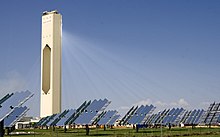| Revision as of 10:02, 6 June 2008 editMac (talk | contribs)23,294 edits ←Created page with '{{main|Solar thermal energy|Parabolic trough|Solar power tower}} [[Image:Moody Sunburst.jpg|thumb|right|Solar troughs are the most widely deployed and cost-effecti...' | Revision as of 10:02, 6 June 2008 edit undoMac (talk | contribs)23,294 editsNo edit summaryNext edit → | ||
| Line 17: | Line 17: | ||
| A solar power tower consists of an array of dual axis tracking reflectors (]s) that concentrate light on a central receiver atop a tower. The working fluid in the receiver is heated up to 500-1000 °C and then used as a heat source for a power generation or energy storage system.<ref name="Martin 2005"/> Power towers are less advanced than trough systems but they offer higher efficiency and better energy storage capability. The ] in ], California and the ] (PS10) in ], Spain are representatives of this technology. | A solar power tower consists of an array of dual axis tracking reflectors (]s) that concentrate light on a central receiver atop a tower. The working fluid in the receiver is heated up to 500-1000 °C and then used as a heat source for a power generation or energy storage system.<ref name="Martin 2005"/> Power towers are less advanced than trough systems but they offer higher efficiency and better energy storage capability. The ] in ], California and the ] (PS10) in ], Spain are representatives of this technology. | ||
| == References == | |||
| <References/> | |||
Revision as of 10:02, 6 June 2008
Main articles: Solar thermal energy, Parabolic trough, and Solar power tower
Concentrated sunlight has been used to perform useful tasks from the time of ancient China. A legend claims Archimedes used polished shields to concentrate sunlight on the invading Roman fleet and repel them from Syracuse. In 1866, Auguste Mouchout used a parabolic trough to produce steam for the first solar steam engine. Over the following 50 years, inventors such as John Ericsson and Frank Shuman developed concentrating solar-powered devices for irrigation, refrigeration and locomotion. The progeny of these early developments are the concentrating solar thermal power plants of today.
Concentrating Solar Power (CSP) systems use lenses or mirrors and tracking systems to focus a large area of sunlight into a small beam. The concentrated light is then used as a heat source for a conventional power plant. Although a wide range of concentrating technologies exist, the most developed are the solar trough, parabolic dish and solar power tower. Each concentration method is capable of producing high temperatures and correspondingly high thermodynamic efficiencies, but they vary in the way they track the Sun and focus light.
A solar trough consists of a linear parabolic reflector that concentrates light onto a receiver positioned along the reflector's focal line. The reflector is made to follow the Sun during the daylight hours by tracking along a single axis. A working fluid is heated up to 150-350 °C as it flows through the receiver and is then used as a heat source for a power generation system. Trough systems are the most developed CSP technology. The Solar Energy Generating Systems (SEGS) plants in California, Acciona's Nevada Solar One near Boulder City, Nevada, and Plataforma Solar de Almería's SSPS-DCS plant in Spain are representatives of this technology.
A parabolic dish or dish engine system consists of a stand-alone parabolic reflector that concentrates light onto a receiver positioned at the reflector's focal point. The reflector tracks the Sun along two axes. The working fluid in the receiver is heated to 250-700 °C and then used by a Stirling engine for power generation. Parabolic dish systems display the highest solar-to-electric efficiency among CSP technologies and their modular nature offers scalability. The Stirling Energy Systems (SES) and Science Applications International Corporation (SAIC) dishes at UNLV and the Big Dish in Canberra, Australia, are representatives of this technology.
A solar power tower consists of an array of dual axis tracking reflectors (heliostats) that concentrate light on a central receiver atop a tower. The working fluid in the receiver is heated up to 500-1000 °C and then used as a heat source for a power generation or energy storage system. Power towers are less advanced than trough systems but they offer higher efficiency and better energy storage capability. The Solar Two in Daggett, California and the Planta Solar 10 (PS10) in Sanlucar la Mayor, Spain are representatives of this technology.
References
- Butti and Perlin (1981), p.68
- Butti and Perlin (1981), p.60–100
- ^ Martin and Goswami (2005), p.45
- "Linear-focusing Concentrator Facilities: DCS, DISS, EUROTROUGH and LS3". Plataforma Solar de Almería. Retrieved 2007-09-29.